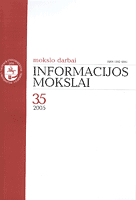Europinės naujienos Europos žiniasklaidoje
European News in European Media
Author(s): Aušra Vinciūnienė, Auksė BalčytienėSubject(s): Economy
Published by: Vilniaus Universiteto Leidykla
Summary/Abstract: The overall objective of this article is to investigate the media’s impact on the European public sphere with regard to actors (persons and institutions on both European and national levels) mechanisms. In the centre of attention is the question how the mass media manage and produce EU coverage and assessment in the context of different journalistic and editorial cultures, standards and ethical considerations in Europe. Comparative studies are performed on multiple levels. Firstly, the news agenda is clarified on a fixed research period (3 weeks during March 2005) from the selected media of 10 participant countries of AIM (Adequate Information Management in Europe) project. Three types of media were assessed, namely (1) national, regional and tabloid dailies, (2) newscasts from public service and commercial TV stations, and (3) (only in some countries) news agency material. Results from comparative study show that, generally, national newspapers heavily invest in EU reporting (Germany, Italy, Ireland). Only in some countries (Lithuania, Norway) regional press is equally active as the national. In all 10 countries very few EU issues are printed in tabloid press (with exception in Great Britain). As a tradition, public service broadcaster outperforms commercial stations in regard of EU reporting. It is no surprise that economic and financial issues receive very high attention from the media. Also, it is little surprise that this type of news (economy) has very text-based approach of news presentation. This result gives a hint that EU reporting is “faceless”, it provides little background information, therefore it is not very well received by the audience. Next step in comparative research study is to concentrate on qualitative analysis of news-making processes in order to gain knowledge and understanding of both internal (newsroom organization, sources that are used by journalists, etc.) and external (communication with audiences and political actors) factors. For this purpose, 15 people will be interviewed in each participating country. It is agreed that respondents will be selected of middle management positions, such as duty/deputy editors, or directors of political or economy news departments, and reporters. The decision-making will be assessed in conventional (print, broadcast) and online-only media, as well as news agencies. This will help to understand routines and procedures as manifested in EU reporting.
Journal: Informacijos mokslai
- Issue Year: 2006
- Issue No: 36
- Page Range: 68-82
- Page Count: 15
- Language: Lithuanian

